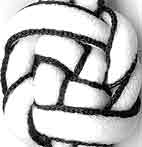Gender and Chinese Knots, Historically
Originally published as a part of the Knot Heads World Wide eZine first issue.
 Western knotting is a very male story involving sailors and cowboys (farmers and mountain climbers) except for a brief interruption for macramé owls and plant hangers. Chinese knotting with it’s strongly decorative bent is a different story… or is it?
Western knotting is a very male story involving sailors and cowboys (farmers and mountain climbers) except for a brief interruption for macramé owls and plant hangers. Chinese knotting with it’s strongly decorative bent is a different story… or is it?
Daily use, practical knots for packages and farm work would likely have known little gender bias as the peasant women tilled the fields alongside their menfolk. Each seamstress would have known how to tie her own buttons and likely a few more decorative touches such as the pipa, double coin and perhaps the pan chang for formal clothing and ceremonial purposes.
Amongst the aristocracy, however, a woman’s life was effectively confined to her house. For a long time, I had the foolishly romantic notion that some of these women (like their Victorian counterparts) might be pouring their frustrations and creative energies into exploring, refining and innovating decorative knots How else might you explain the plafond knot?
Alas, for my political agenda, I eventually learned that the palace was supplied by a large group of skilled artisans (braiders and knot tyers among many others) who were presumed male. At this point, let me explain that as a modern woman, I am very much attracted to the idea of women having an equal (or at least significant) hand in the creation of knowledge now, of course, but especially in our past. I am predisposed to be biased and gravitate towards explanations that support my desired conclusions.
When Artisans in Early Imperial China by Anthony J. Barbieri-Low was published, I purchased it with the expectation of learning what the lives of these artisans was like. It was therefore surprising and delightful to learn that artisans were drafted to serve the palace much as soldiers were drafted to serve in the armed forces. That is to say, when a family was called to serve in some capacity, the rest of the family was exempt from other demands for service. So, if a member of the family was serving as an artisan, the state could not then demand another member of the family to serve as a soldier or labourer. Further, when a demand for artisans was applied to a particular area, the usual quota was a preference for females at a ratio of 2 to 1. They hoped to conscript two women for each man or child designated to serve. While knotting and braiding are not specifically mentioned in the discussion of female artisans, the allied arts of embroidery and weaving are.
So, when picturing the knot tyer of ancient China: creating a plafond knot, tying a large and intricate pan chang, or tassels for the throne and the imperial seal; don’t think of the cloistered wife of a rich lord toiling in her opulent inner rooms. Don’t think of a man, working with his brethren, with the wives all waiting for them at home. Think of a woman valued for her knowledge and skill, at a time when women were not considered real people equal in rights and opportunity, producing works that are in high demand and at the same time protecting her family from the need to go off to war or submit to back breaking labour in appalling conditions.
by Carol Wang http://chineseknotting.org/
Books mentioned in this article:
Comments
if Mulan were a better weaver...